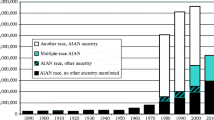Abstract
Since 1960, the Native American population has exhibited explosive growth, increasing from 552,000 to 1,959,000, or 255 percent. The average annual growth rate of 4.3 percent, extending over a 30-year period, is demographically impossible without immigration – in fact, of the 1.4 million growth only 762,000 comes from natural increase, whereas 645,000 comes from non-demographic factors. This paper expands on previous work to illustrate with demographic techniques how such extraordinary growth was achieved through changing patterns of racial self-identification on the part of people with only partial or distant American Indian ancestry, coupled with relatively high fertility and improving mortality. It also provides some basic demographic background on the size, growth, and geographic structure of the American Indian population, while exploring both demographic and geographic underpinnings of the changing population. Data on race from the 1970, 1980, and 1990 Censuses are based on self-identification. A person choosing the American Indian racial response does not have to provide any substantiation or documentation. While this method aids overall census taking by permitting respondents to fill out their own census forms, self-identification adds a temporal component to the data because responses elicited from the same individual (or group of individuals) may change over time in reaction to social, political, or economic conditions or variations in question wording. New identities may emerge or old ones may disappear. This effect has had a noteworthy impact on data for American Indians. Analysts and other data users must be aware of underlying response patterns to interpret changes correctly.
Similar content being viewed by others
References
Eschbach, K. (1993). Changing identification among AmericanIndians and Alaska Natives, Demography 30(4): 635–652.
Fix, M. & Passel, J.S. (1994). Immigration and immigrants: Setting the record straight. Washington, DC: The Urban Institute.
Hahn, R.A., Mulinare, J. & Teutsch, S.M. (1992). Inconsistencies in coding of race and ethnicity between birth and death in US infants, Journal of the American Medical Association 267: 259–263.
Harris, D. (1994). The 1990 Census count of American Indians:What do the numbers really mean?, Social Science Quarterly 75: 580–593.
Passel, J.S. (1976). Provisional evaluation of the 1970 Census count of AmericanIndians, Demography 13: 397–409.
Passel, J.S. (1992). Thegrowing American Indian population 1960–1990. Unpublished paper, presented at the annual meetings of the American Statistical Association, Boston, MA, August 1992.
Passel, J.S. & Berman, P.A. (1986). Quality of 1980Census data for American Indians, Social Biology 33: 163–182.
Robinson, J.G., Ahmed, B., Das Gupta, P. & Woodrow, K.A. (1992).Estimation of coverage in the 1990 United States Census based on demographic analysis. Unpublished paper of the Population Division, US Bureau of the Census, Washington, DC.
Snipp, C.M. (1989). American Indians: The first of this land.New York: Russell Sage Foundation.
Waters, M.C. (1990). Ethnic options.Berkeley: University of California Press.
Author information
Authors and Affiliations
Rights and permissions
About this article
Cite this article
PASSEL, J.S. The growing American Indian population, 1960–1990: Beyond demography. Population Research and Policy Review 16, 11–31 (1997). https://doi.org/10.1023/A:1005724610787
Issue Date:
DOI: https://doi.org/10.1023/A:1005724610787




